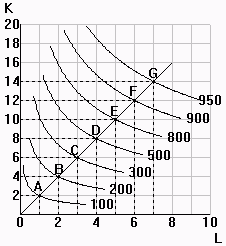|
3. |
(From Frank, Chapter 9) Identify the regions of increasing, constant,
and decreasing returns to scale in the isoquant map to the right IRTS region(s) = C-D-E CRTS region(s) = A-B-C DRTS region(s) = E-F-G |
 |
|
Homework exercises #10: KEY |
||||||
|
|
1. |
a. | (From Frank, Chapter 9) A wag once remarked that when a certain government official
moved from New York to California, the average IQ level in both states
went up. Interpret this remark in the context of average-marginal
relationships. The politician's (the marginal) IQ was below the average for New York but above the average for California.
|
||||||||||||||||||||||||
| b. | (From Frank, Chapter 9) True or false: If the marginal product is decreasing,
then the average product must also be decreasing. Explain. False. AP increases when MP is above it, regardless of whether MP is rising or falling.
|
|||||||||||||||||||||||||
|
2. |
(From Frank, Chapter 9) The following table provides partial information on total output, average product, and marginal product for a production function. Use relationships between these properties to complete the table: | |||||||||||||||||||||||||
|
||||||||||||||||||||||||||
|
3. |
(From Frank, Chapter 9) Identify the regions of increasing, constant,
and decreasing returns to scale in the isoquant map to the right IRTS region(s) = C-D-E CRTS region(s) = A-B-C DRTS region(s) = E-F-G |
 |
| 4. | Suppose that the technology of the QKL Company
can be summarized by the following production function: Q = 6.25·K1L1/2 where Q = output, K = quantity of capital, L = quantity of labor. |
|
| a. | What kind of returns to scale characterizes QKL's production?
Explain. IRTS: Cobb-Douglas production function, and exponents sum to 1.5 => output rises 1.5 times the rate of increase of inputs.
|
|
| b. | Calculate the following mathematical formulas for this
production function's: (1) marginal product of labor (MPL) = 3.125.K1L-1/2 (2) marginal product of capital (MPK) = 6.25.L1/2 (1) MPL = dQ/dL = (1/2).6.25.K1L1/2-1 = 3.125.K1L-1/2 (2) MPK = dQ/dK = 1.6.25.K1-1L1/2 = 1.6.25.K0L1/2 = 6.25.L1/2
|
|
| c. | Are there diminishing marginal returns: (1) to labor? Yes (2) to capital? No Verify both answers mathematically. (Hint: Do this by taking the derivative of MPL and MPK and examining their sign.) (1) dMPL/dL = (-1/2)·3.125·K1L-3/2 which is < 0, so MPL falls as L rises => diminishing marginal returns to L. (2) dMPK/dK = d(6.25·L1/2)/dK which = 0, so MPK is constant at K rises => constant marginal returns to K |
|
| d. | By approximately what percentage does output rise: (1) If capital is increased by 10%? 10% (2) If labor is increased by 10%? 5% (3) If both capital and labor are increased by 10%? 15% |
|